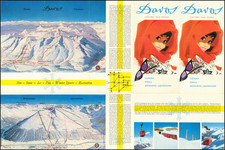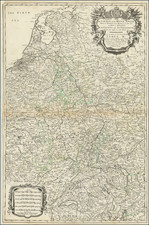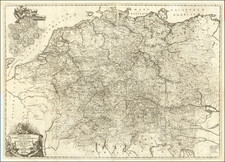The Earliest Surviving Modern Map of Switzerland
Rare early Lafreri School map of Switzerland, published in Rome by Antonio Salamanca.
Salamanca's map is drawn from the first edition of Sebastian Munster's 9 sheet map of Switzerland, which was drawn from the manuscript map of Aegidius Tschudi's map of Switzerland. However, neither the first edition of Munster's map, nor the original Tschudi manuscript have survived to modern times, making this Salamanca map the earliest surviving example of Tschudi's map.
Aegidius Tschudi (1505–1572), known foremost as a historian, is considered to be one of the pioneers of Swiss cartography. In 1528, he drew a map of Switzerland which is the earliest known map of the the whole of region. The map survived in manuscript form until 1538. when it was published with the printed title of Nova Rhaetiae atque totius Helvetiae descriptio by Munster. The Munster map survives only in a single example of the second edition, which was printed in 1560. The Munster map is also oriented with South at the top (as are most later Tschudi copies, such as Abraham Ortelius' map), making Salamanca's work all the more interesting.
Tschudi's map was the first time the entire area of what was later known as Switzerland was shown on a single map. For more than half a century, the map was considered the best representation of the area and was therefore recut or re-engraved many times.
Tschudi produced his map of Switzerland in part based on his own harrowing expeditions through the Alps. Tschudi gave a manuscript version to his former teacher Heinrich Glarean, who in turn passed it on to Sebastian Münster, who printed a woodcut version of the map. A friend of Tschudi's, Jost von Meggen brought one of Münster's two woodcut editions of the map to Rome when he was appointed head of the Papal Guards in 1546 (Karrow pp.547-550). At some point, the map found its way to the workshop of Antonio Salamanca, who produced this edition, which was later copied by Antonio Lafreri.
Rarity
At the time of Walter Brumer's article on Tuschdi's map, Blumer reported that the Salamanca map was known in only 1 example, at the University Library at Basel. However, since that time, additional examples are known to survive.
The present example is apparently the only example of the map to come to market in many decades.
The Lafreri School is a commonly used name for a group of mapmakers, engravers, and publishers who worked in Rome and Venice from ca. 1544 to 1585. The makers, who were loosely connected via business partnerships and collaborations, created maps that were then bound into composite atlases; the maps would be chosen based on the buyer or compiler’s interests. As the maps were initially published as separate-sheets, the style and size of maps included under the umbrella of the “School” differed widely. These differences can also be seen in the surviving Lafreri atlases, which have maps bound in with varying formats including as folded maps, maps with wide, trimmed, or added margins, smaller maps, etc.
The most famous mapmakers of the School included Giacomo Gastaldi and Paolo Forlani, among others. The School’s namesake, Antonio Lafreri, was a map and printseller. His 1572 catalog of his stock, entitled Indice Delle Tavole Moderne Di Geografia Della Maggior Parte Del Mondo, has a similar title to many of the composite atlases and thus his name became associated with the entire output of the larger group.
Antonio Salamanca was a print seller and publisher based in Rome. While he was known by the surname Salamanca, his family name was actually Martinez; he hailed from Salamanca, Spain. His shop was in the Campo de’ Fiori and it served as a gathering place for those with antiquarian interests. Later in his career, he partnered with Antonio Lafreri, the era’ most prominent Italian map publisher. Salamanca’s stock was sold to Lafreri after the former’s death.












![Gallia Narbonens [on sheet with] Savaudiae Ducat. [on sheet with] Venuxini Comitatus Descr.](https://storage.googleapis.com/raremaps/img/small/61471.jpg)
![[Course of the Rhine River] Corso del Reno Parte Septentrio [and] Corso del Reno Parte Meridionale . . . 1690](https://storage.googleapis.com/raremaps/img/small/73095.jpg)
![Carte de Suisse ou sont les Cantos de Zurich, Berne, Lucerne, Uri, Schwitz, Underwald, Zug, Glaris, Basle, Fribourg, Souleurre, Schaffouse, et. Appenzel . . . [Augmentee en 1759 Par Phil. Buache]](https://storage.googleapis.com/raremaps/img/small/93975.jpg)